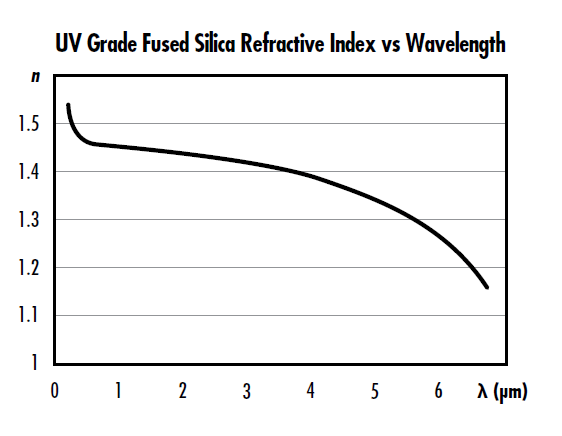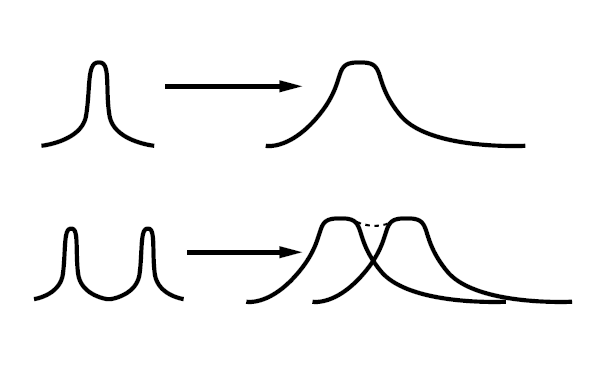色散
雷射資源指南第8.8部份。
色散是光在穿透光學介質時,其相位速度或相位延遲與其他參數之間的相依性,例如光學頻率或波長。雷射光學 基底: 內部可能發生多種不同類型的色散,例如色度 (圖 1), intermodal, and polarization mode dispersion.1

圖 1: 紫外線級熔融石英折射指數作為波長函數
色度色散
折射指數 是指真空中的光速,與穿透介質(例如空氣或玻璃)時光波相位速度之間的比率。脈衝雷射應用普遍以頻率描述光線,因為一般而言時間更為關鍵,而光線頻率為固定值,且其波長需視其穿越環境內部的折射指數而定。波長 $ \small{\left( \lambda \right)} $ 與角頻率 $ \small{\left( \omega \right)} $, 折射指數 $ \small{\left( n \right)} $, 及光速 $ \small{\left( c \right)} $ 有關:
材料折射指數通常以 Selmeier 公式及材料常數 $\small{B_1}$, $\small{B_2}$, $\small{B_3}$, $\small{C_1}$, $\small{C_2}$, and $\small{C_3}$:
色度色散為光線在介質中的相位速度 $\small{\nu _{p}}$ ,與光線波長之間的相依性,大多是由光線與介質電子之間的互動所產生。色度色散是以阿貝數 (圖 2), 描述,對應於與 $ \small{\lambda} $, 相關折射指數第一偏導數的倒數,而部分色散則對應於與波長相關折射指數的第二導數。
阿貝數公式如下:
$\small{n_D} $, $\small{n_F} $, 及 $\small{n_C} $ 為基材 Fraunhofer D- $ \small{\left( 589.3 \text{nm} \right)} $, F- $ \small{\left( 486.1 \text{nm} \right)} $, 及 C- $ \small{\left( 656.3 \text{nm} \right)} $ 光譜線波長情況下的折射指數。材料阿貝數也可利用與波長相關的折射指數導數,於任何波長描述:
In laser applications, the primary concern is how dispersion will affect the properties of a laser pulse traveling through the medium, which is described by group velocity - the variation of the phase velocity of light in a medium relative to its wavenumber:
The wavenumber $ \small{\left( k \right)} $ is $ \tfrac{2 \pi}{\lambda} $ - this concept is sometimes also referred to a spectral phase. As multiple wavelengths of light transmit through a material, the longer wavelength (lower frequency) typically travels faster than shorter wavelengths (higher frequencies) because the group velocity is wavelength-dependent.2 This results in a spectral spreading of the wavefront phase similar to the way light transmitting through a prism is dispersed into its component colors. Group velocity is defined as the first derivative of the phase velocity with respect to frequency, and the group velocity dispersion $ \small{\text{GVD}} $ is similarly defined as the derivative of the inverse group velocity with respect to frequency:
Group velocity is similar to spectral dispersion as they both correspond to the first derivative of refractive index with respect to wavelength or frequency. Likewise, $ \small{\text{GVD}} $ is similar to partial dispersion in that they are both second derivatives with respect to wavelength or frequency. Minimizing $ \small{\text{GVD}} $ in an optical design is similar to designing to minimize chromatic focal shift, except the designer will focus on group velocity and $ \small{\text{GVD}} $ rather than the Abbe number and partial dispersion.
A further discussion of $ \small{\text{GVD}} $ and its importance for ultrafast laser optics can be found in our Ultrafast Dispersion application note.
模間色散
模間色散為波導(例如多模光纖)之中光線群速與光學頻率及傳播模式的相依性。2 在多模光纖通訊系統中,這會嚴重限制可達到的資料傳輸速率或位元率。如需預防模間色散,可利用具有拋物面折射指數的單模光纖或多模光纖。
極化模態色散
極化模態色散是介質中光線傳播特性與極化狀態的相依性,可能在高資料速率單模光纖系統中具有重大意義。這三種色散都可能在自由空間或光纖暫時擴大或壓縮超短脈衝,可能讓個別脈衝混合在一起導致無法辨識 (圖 3)。

圖 3: 色散可能造成通過光纖的雷射脈衝散射,直到無法辨識為止
參考資料
1 Paschotta, Rüdiger. Encyclopedia of Laser Physics and Technology, RP Photonics, October 2017, www.rp-photonics.com/encyclopedia.html.
2 Ghatak, Ajoy, and K. Thyagarajan. “Optical Waveguides and Fibers.” University of Connecticut, 2000.













 上個章節
上個章節 















or view regional numbers
QUOTE TOOL
enter stock numbers to begin
Copyright 2023, Edmund Optics Inc., 14F., No.83, Sec. 4, Wenxin Road, Beitun District , Taichung City 406, Taiwan (R.O.C.)
Privacy Policy | Cookie Policy | Terms & Conditions | Accessibility
California Consumer Privacy Act (CCPA): Do Not Sell My Information